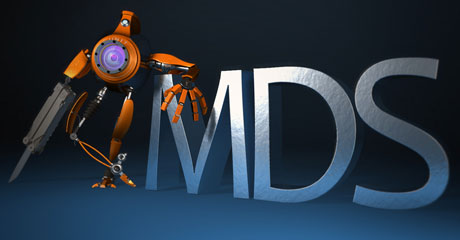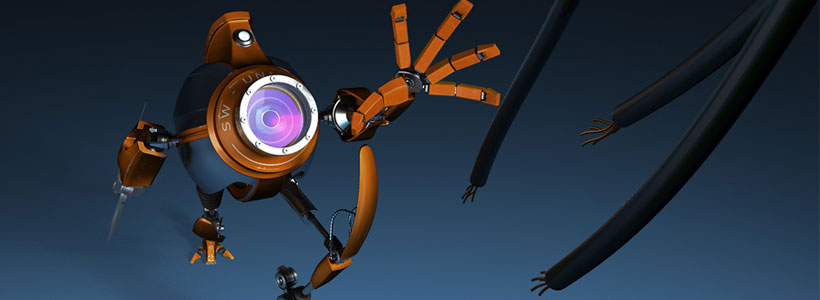This week we speak to Sergej Zlahtic who is currently a student at New Zealand’s Media Design School in Auckland. Sergej is originally from Slovenia, a small country in the heart of Europe, and he’s enrolled at the Advanced 3D Productions course that the school offers. In this interview he talks about his experiences as an international student and what made him pick the Media Design School over other educational institutions around the world offering similar programs, as well as how his 3D journey has been so far.

What first sparked your interest in computer arts and how did you get started?
My first eduaction is kindergarten teacher. I really like kid’s books and toys, that’s why I decided to go more into a multimedia area and try to combine my kindergarten knowledge with digital art. Suddenly I started working on different projects and I figured out that I didn’t have enough knowledge to realize my ideas. At that point I saw that 3D was the area that I should follow.
What made you pick this school in particular?
Before I came to New Zealand I checked out a lot of different schools (Vancouver Film School, SAE, Korea..). On the web I found Media Design School in Auckland and checked out their student work. I was really impressed by the quality of their students. When I contacted them they answered within a few hours, at that point I knew that the student as an individual is really important to their business.
Can you tell us a bit about your specific course?
I am enrolled at the Advanced 3D Productions course, which takes 40 weeks of hard studying every day.

The entry requirements are three letters of recommendation, an interview and a portfolio. The other unofficial requirement is the ability to work in a team, which from my point of view is also the most important.
If you successfully finish the course you’ll get the graduate diploma (NZQA level 7). In some countries this diploma is not recognizable but apparently this industry looks to hire people that can DO things.
How was the application procedure?
MDS is very oriented towards international students. So, they try to sort a lot of the paperwork for you and give you good instructions. They don’t help you with accommodation which is a pity but when you come to Auckland you can find accommodation really quickly.
The student visa procedure from my country was really fast. It took me four days with delivery. But when I applied for my second year from New Zealand it took me two months, with a lot of unreasonable complications. Definitely a huge minus on the immigration process…

Can you tell us a bit about your experiences during the first few weeks when you came to New Zealand?
First few weeks of New Zealand were really interesting. “Kiwi-English” become something new for me as I couldn’t really understand their accent. But eventually you get comfortable with it.
It’s really amazing how Kiwi people are relaxed and friendly. Wherever you go they start talking to you!
During studies at MDS we changed the location of the school to a bigger building. The new location offers a creative environment right in Auckland’s city center. At the school we have a studio room, a theatre room and lots of space to socialize.
At the end of every month we have student drinks and for international students they also organize trips around New Zealand.
Getting around a new piece of complicated software can take a bit of time. What different software have you worked with so far and did you have any experience with it before you started?
For 3D we use Autodesk Maya and Autodesk Mudbox. For compositing we use Foundry Nuke, Adobe After Effects and Adobe Photoshop.
Before I started studying at MDS I hadn’t used any 3D software. Actually, I hadn’t had any 3D experience! All 3D I’ve learned was at school. Before school, I was familiar with InDesign, Illustrator, Photoshop, Dreamweaver and After Effects.
Here at MDS the tutors guide you through 3D software with everyday formatives that you have to submit daily. With that kind of approach they force you to study hard every day.
Do you feel that being in school has given you a better idea of production pipelines and will give you an advantage when looking for work after graduation?
Media Design School gave me a really good idea of what the industry should look like. Our tutors are really amazing and they come straight from industry.
Right now, we are in the middle of a short movie production with James Cunningham, where they guide us through the whole production pipeline.
The production duration is 12 weeks and every single day we have to write a report about our progress. If they think there’s something you can do better they give you good instructions to work from and help you improve.
The point of everything is to learn how to solve everyday problems and be critical about your own work.

What’s the student community like at your school and do you think it’s easier to learn and grow as an artist when you’re surrounded by like minded people?
If you work as an individual you can’t really produce good work. Everything is team based and in our class we talk to each other a lot. With this kind of work ethic we solve problems faster and achieve better results.
In my opinion, it is really important for a team that there are people with different knowledge and from different parts of the world. Our team has eleven people, hailing from places like Venezuela, South Africa, Spain, Slovenia and New Zealand.
In terms of education it’s often said that you get back what you put in. So how much time do you put in?
Every day, I have four regular hours plus at least six hours of extra studies. As extra studies I count reading the Maya help documentation, forums, articles, interviews, tutorials and talk with my classmates. It helps if you study a lot, but at the same time you have to do other stuff, not related to work. There is not just school, but other nice things that will help develop your creativity.
How does a typical day of school look for you?
Every day we start at 8.30 am. Before that time you have to submit assignments from the previous day – don’t be late. Tutors check your daily assignment and give you feedback. If you don’t achieve the requirement standards you have to resubmit the formative.
At 12.30 pm you go for a one hour break, then back to work till you are happy with the result. School is open till 9.00 pm. During weekends you usually don’t work, but reality is you can’t stop thinking about it.
The instructors are an important part of the school as they’re responsible for the quality of the curriculum. What do you think of the level of knowledge and experience when it comes to your instructors?
Our instructors come from the industry. That’s why they usually give you the kind of opinion that you will get in the industry.
Your showreel is one of the keys to landing a job in this field. How much of your time has been focused around this so far?
I am checking different companies all the time and I try to figure out what kind of people they are looking for. So, I try to put more time into the fields that companies are looking for.
School is preparing us to be generalists, but in the end, you still need an area that you are good at and people will hire you off the base of that.
Networking is also one of the things that can help you with finding a job in this industry. Do you think by going to school you might have made some useful connections that you wouldn’t have made otherwise?
Yes, definitely. MDS itself is closely connected to the industry; our tutors come from the industry with numerous experiences, so they know what the expectations are and what things would be good for students to know in order to be efficient in a production environment.
From time to time, the school organises workshops and presentations with key people from the industry – this offers you the opportunity to liaise with these people and make connections.
What kind of student is the New Zealand Media Design School best suited for in your opinion?
In my opinion, our school is mainly suited for people looking to develop themselves in the film and advertising industry.
Do you have any experiences that stand out that you’d like to tell us a bit about ?
When I started at this school I didn’t know it had such an important industry network – bringing so many important names to the school to give lectures.
For instance, Andrew Gordon from Pixar Animation, Sebastian Marino from 77 Pieces, people from Weta, etc. This is a significant opportunity and one of the most important things the school can offer.
What are your plans after you complete your studies?
First thing I am planning after school, would be to have a good rest and recharge my batteries. After that, my work and energy will be oriented towards finding a job.
New Zealand strongly supports this industry and gives the opportunity for young people like me to stay here and continue their career, especially if you finish your studies in New Zealand within the 3D area.
The land of Kiwis has a lot of good studios I’m very keen to work for. Let’s see what will happen…

Is there anything you feel you’ve gained from your time at school that you wouldn’t have been able to get if you were learning from home on your own?
I definitely save on time! If I wanted to gain this knowledge on my own, I would need at least three years of hard work. School motivates and puts you on track so you don’t lose time. It’s definitely the most efficient way to gain such a strong knowledge.
